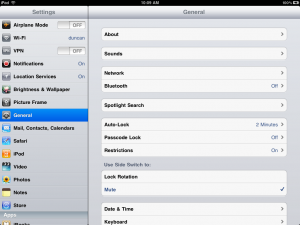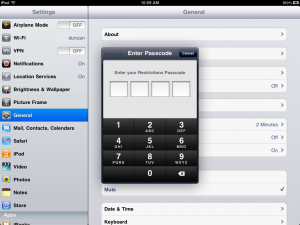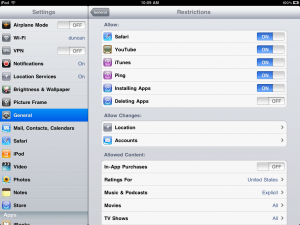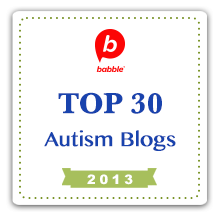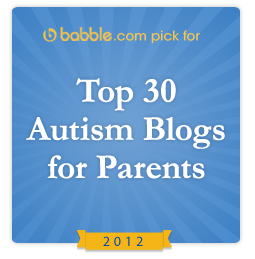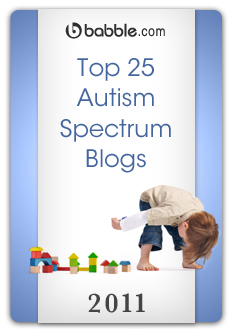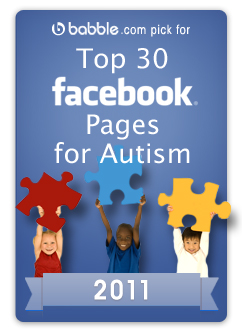Christmas is stressful enough for parents, having to budget and shop and organize and decorate and so forth… it becomes that much worse when you consider that your child or children won’t even enjoy all your efforts. Quite the opposite, it might be too much for them and ultimately become a disaster.
I won’t be able to solve all your problems, the vast number of issues that children can have in such a hectic and very big period of time can’t really be covered in just one blog post. But I do have some suggestions that will hopefully make it a bit easier.
Christmas Shopping

Cameron's First Christmas 2005
The great thing about malls and stores starting the holiday shopping season so early is that it gives those of us with Autistic children a pre-boarding pass. It means we can avoid the crowds and craziness and just take our time. Most of us don’t, but we could… and we should.
Actually, you should start shopping in January if you can help it. If you’re like me, Autism and having a family in itself can drain the bank account quicker than we’d like. So us Autism parents have to spread out the shopping through out the year even more than most families, and it’s a good idea for everyone. If you spend $50 on one present each month for 3 months, it’s far easier to manage than to spend $150 on 3 presents from one paycheck in November or December.
Speaking of November, early November is a great time to get your children into the stores to start window shopping. Take some notes and see what they like, what they don’t like. It allows them the freedom to really think about the toys rather than the other kids around them, the crowds all talking at once and so on.
It also gives you a stress free outing (or less stress anyway) where you can really get some good vibes from them.
Another alternative is catalogues. Everyone’s done the catalogue thing, where you circle toys/games that you want. This is something that even non verbal children can do, they don’t have to get it perfect but can usually get the message across to you.
The down side to shopping in November is that their wishes may change in 2 months, but it’s a risk worth taking. Even if they decide they want something else in that time, they’ll likely be reminded and very happy once they see what they were thinking about just a short while ago.
Decorations
The good thing about decorations is that they come in all shapes and sizes, however the bad thing is that some will have an adverse effect on your Autistic children. And the affect it might have can be so subtle that it might not show up for several days. Blinking lights, glittery objects, sound making trinkets all over… these can wear down the senses over time without anyone even realizing what it was.
A few things should be in your mind:
- If you insist on lights (and who doesn’t?), pick lights that stay on, or have settings such that you can have them blink from time to time but be set to be consistently on the rest of the time.
- Some tinsel is nice, but if you have bright lights aimed around or aimed at the tree, these and other decorations can give off blinding little flashes that you and I might not think much about but can get very frustrating. If you notice your child ‘retreating’ from the room or finding a favourable spot, it may be because it has the least glare.
- Some singing or noise making decorations are great, they’re especially great if they are activated in some way. For example, a singing plushy that goes when you press a paw or foot is a great way to give your children control of it. Random sounds can be a little scary.
- Background music is best kept in the background, if at all. That means, keep it quiet. If you have it to where you can make out the words and sing along, it might be too loud for your little one. Remember, your children might not have a ‘background’ setting when it comes to their senses. That means that what you barely notice is there, they hear perfectly clearly and are having to battle that music while trying to listen to you. If they don’t listen to you, it might just be that they don’t actually hear you.
- Get your children to help with decorations. Have them decorate the bottom half of the tree, or along some railings inside the house… someplace low. Getting them involved is a wonderful way of helping them cope with them being there. They feel a huge sense of pride but also comfort in knowing that the decorations are there because they put them there. They remain ‘in control’ of their space.
Family Gatherings
The best you could do is to have everyone to your house for Christmas but unfortunately this just isn’t a reality for everyone. Whether it be a small house, distant family or just that family would like to host their own gatherings sometimes, you’re just going to have to face the reality that you will have to leave the comfort of your own house.
First and foremost, before anyone goes anywhere, try your best to make family realize that your child is going to be overwhelmed. Have patience, you can handle it, your child doesn’t mean to be bad and could possibly come across that way at some point. Some might not understand no matter what you say but at least you will have said it, and some will ‘get it’ and hopefully speak up for you when you’re not there and someone makes a comment. It does happen.
Also, your family has to realize that your child will very likely not hug them, much less give them kisses, to get their presents or treats. Don’t let anyone force your child into that sort of situation. It’s like asking an arachnophobe to go into a room full of spiders. The first person they have to reluctantly hug for something in return may be the trigger that makes the rest of the night unbearable. Make sure your child says please and thank you but that’s it, no one should expect more than that.
If you do get Christmas at your house, discuss ‘safe zones’ with your children. Someplace they feel safe, it’s quiet, comfortable… set up some toys or anything else they like such that they can retreat when need be. They might just disappear there the whole time but it’s better than what could be the alternative.
Going to someone else’s house to celebrate the holidays doesn’t give you a safe zone but that shouldn’t stop you from finding one. If your child needs space, take them there. Don’t make it a time out zone or anything, but just a place to get away. Let the family think they’re being taken off as a punishment if they truly don’t understand, but don’t let your children think that. It’s just meant to be a way to ease the senses.
Also, forget about dressing them up to look good. You seriously have to put away the expectations or opinions, even from family. If they can’t understand that your child simply can not wear those fabrics or collars or what ever, then too bad for them. They’ll just have to talk behind your back. Your child comes first before their attire opinions.
Food
When it comes to differences in Autism, food is a huge factor. You could have thousands of children all in a room and no two of them would have the same diet. Family will never ever listen but it still doesn’t hurt to tell as many people as you can to NOT FEED YOUR CHILD ANYTHING.
It’s a ground rule with my family, they know it now and abide by it but still, sometimes things slip. Just last night even, a family member was going to give my son a rice crispy treat until another family member spoke up and said “you better check with his mom and dad first”. She did. Turns out, it had gluten in it, which Cameron is not allowed.
And that’s the key right there. If you get enough family members on board, someone might speak up in time even if some family members don’t know or won’t listen. It could save you a lot of trouble later on.
You can try to educate as many people as you can but ultimately the best solution is to just tell everyone not to give your children food. They will be so very tempted to spoil your kids, that’s what family does. But hopefully after a Christmas or two, or some right words, they will listen to you.
For us, our family had to actually see my son bouncing off the walls after eating gluten, and witness the radical change in him to understand just how much it affects him and why we are so very adamant about this basic rule.
Presents
Let’s face it, you can’t tell everyone what they should or shouldn’t get you. And telling everyone to just send you cash doesn’t make for a very fun Christmas.
Hopefully if you’ve done your window shopping early enough, as described earlier in this post, you will have the time to send out some ideas to family from your list.
If not, the question has been asked of me if I’d be happy or offended that family tries to get sensory friendly toys for my boys. The answer is, I’d be thrilled. Even if not quite right, it would show me that they actually ‘get it’ and are trying.
That being said, a good general rule of thumb that my wife and I go by is to let them get what they want to get… and keep the educational and sensory presents up to us. After all, who could possibly know better what to get in those departments than us? And what family member wants to get a boring educational toy when something else would look more fun?
In the end, you just have to remember that every parent has a child that gets presents that are just not appropriate, or just too loud, or just simply unwanted… having a child with Autism might make it more likely but it does happen to everyone.
Don’t get offended, don’t make a big deal out of it. Just prepare as best you can ahead of time with family. Give them the freedom to get a wrong present. It’ll be ok. It’s Christmas after all. They only want to try to put a smile on their little faces.
Santa Claus
For the first few years, when your child is 3 – 6’ish, depending on how well they’re adjusting, Santa might be best left to the television screen or in a parade. Let’s face it, to a little child that is unable to look their own mother in the eye, Santa can be a tad… scary. Not so much scary in the sense that you or I think of being scared, but simply overwhelming. Santa is made out to be big, hairy, bright in his red suit and a loud boisterous ‘HO HO HO’… to a child with Autism, and many children in general really, Santa can simply be too much.
That’s when you get those pictures of children bawling their eyes out on Santa’s lap.
Don’t ever think that you’re child is missing out either. Really. Santa is no less magical when you see him on a parade float or performing magic in a movie. Santa is that overwhelming for a reason. Every child loves Santa from a distance. It’s the close up that is iffy.
Sacrifices
In the end, it all boils down to some small sacrifices. You will likely be leaving early before the music gets loud (or the people do), plus, your child likely has a very strict routine making bedtime a necessity. You’ll likely be missing out on a meal or two here or there through the holidays as you stay with your child, or console them, or take them home… you’ll likely be missing out on great presents that are too much for your child to handle, you can’t put up the decorations you really want to, just in case.
It all sounds pretty brutal and if it’s all stuff that you really love about the holidays, then I’m sorry, it will be brutal.
But I would like to think that these sacrifices, even if tradition or you just really want them, they’re small sacrifices to make.
A couple of years without tinsel and you’ll wonder why you ever used it. A couple of years of telling family members not to feed your child and they’ll get it. They’ll likely even learn what foods they can feed them that you gave them last year.
A couple of years and your child will be able to handle the lights and sounds better as they mature, so it won’t be so bad. Their bed time might even be later by then.
If you can avoid a meltdown or two simply by being prepared, getting out earlier than most, educating family, having a plan for safe zones or times to leave…. it’s so worth it. Not just for you but for your dear children. They don’t want a meltdown at Christmas any more than you do. After all, this holiday is for them, the magic is for them.
I would love to hear about tips/tricks that you’ve learned through out the years to make Christmas a little ‘safer’ for those with Autism in your family. Please feel free to share.
![]()



